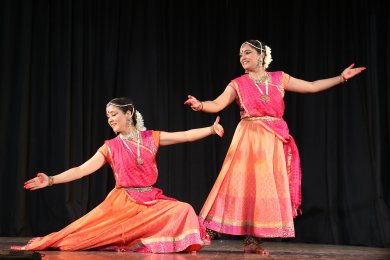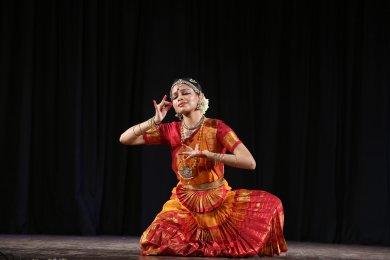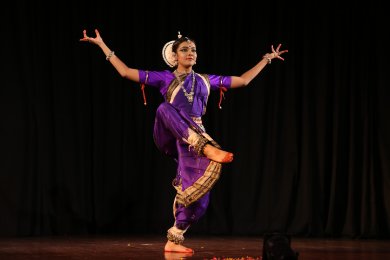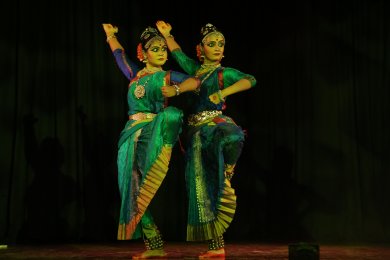
|   |

|   |
 e-mail: leelakaverivenkat@gmail.com Varsha Ritu draws showers of appreciation Photos courtesy: IIC July 27, 2017 Varsha Ritu, the annual Monsoon festival mounted by the IIC (July 19 & 20), designed by late cultural activist Manna Srinivasan in 2010, has over the years, judging by the handsome audience response, evolved into an event on the cultural calendar of the International Centre, that members look forward to. Mainly built round budding young dancers of different dance forms, the one hour performance slots incorporating at least one specially composed thematic item woven round the Monsoon season, have exuded freshness, creating a growing sense of expectancy in the viewers – often captivated while watching less publicised talents.  Leena Malakar Vij and Purnima Roy Chaudhury Providing the curtain raiser, Kathak dancers Leena Malakar Vij and Purnima Roy Chaudhury, disciples of Jaipur gharana specialist Nandini Singh, performed with an infectious sense of joy. The recital held together by the finely controlled mellifluous vocal support of Shoab Hassan with Babar Lateef on the tabla, in the opening invocation Pratham sumeer Sri Ganesh in Desh set to Chautal, (bearing the still un-erased signature of late Pandit Durga Lal) brought back stirring nostalgic memories for those in the audience who had seen the Kathak master in action. Also from Durga’s repertoire was the finale of Tarana in Bageshwari set to jhaptal. While the two dancers combined well, the more contained dancer was Poornima Roy with a sedately still torso. Leena Malakar, given her involvement and swaying grace of movement, could perhaps control her exaggerated torso genuflexions – to preserve the Kathak angik profile. In the teental, vilambit, thaat, Amad and the expanding ‘thei tat ta’ movements with delicate rhythmic flourishes woven in with the later chals and chakkars,’ the twosome had a smooth stage understanding, aiding clean presentation. The Monsoon feel came with the thumri in Megh Malhar - a composition of Gyan Prakash Ghosh, with the sahitya exulting on impending rains with dark clouds (Ghana Ghana ghora) with the dance motifs revelling in the conventional images of the season, with birds and deer and dancing peacock rejoicing in the weather, followed by the inevitable ending of the nayika’s note of wistful longing Piya ghara nahi aye. The Ardhanariswar Sloka in Pooryadhanashree, the score being by Madhav Prasad, saw the taller Leena taking on the tandav Shiva poses matched with Poornima’s lasya imagery as Parvati. While the lasya/tandav contrast was clear, the choreography, through fine tuning should aim at a more compact canvas in one frame – to give the feel of one entity embodying the polarities of Shiva/Shakti in Ardhanariswar.  Priya Srinivasan Bharatanatyam represented by a more experienced dancer Priya Srinivasan bore the unmistakable stamp of the Kalakshetra background in every aspect of the presentation - from the costuming aesthetics to repertoire – not to speak of her clean movement lines and perfect technique. She was accompanied by an equally disciplined musical team led by the nattuvangam of Kapil Sharma (disciple of Leela Samson) with vocal support by Prashant G. Pai, mridangam by Jayan P Das and Rajat Prasanna on flute. Priya began with the Tulsidas Bhajan Sri Ramachandra Kripala Bhajman, (the dance composition being by Sheejith Krishna) which she followed up with the padam, Dari joochu chunnadi in Shankarabharanam, the dancer’s netrabhinaya eloquently conveying to the nayaka the state of her friend, his beloved – passing the hours with her lotus eyes eagerly scanning the street expectantly, for his arrival. Anandanadamidum padam in Kedaragowla (dance composition by Leela Samson) also met with a finished rendition. The Dharmapuri Subbarayar Padam Era rara in Kamas as visualised by Bragha Bessel who over the last few years has been the abhinaya teacher for Kalakshetra, was charmingly interpreted bringing out the smitten nayika’s invitation to her loved one Venkateshwara to unite with her, putting an end to the torture of unrequited love. Priya concluded with a neatly performed Lalgudi Jayaraman Tillana in Madhuwanti. Strangely in this well executed suite of items, one missed a specially composed number treating the Monsoon theme.  Arnaz Zaman Totally unknown, young Odissi dancer Arnaz Zaman, a disciple of Kavita Dwibedi for the last six years, spun her way into audience hearts with her unspoilt innocence combined with a rare gift for total immersion in the dance. Trying to conquer her nervousness at the start, Arnaz however projected right from the opening Mangalacharan with Shiva stotram in raga jait, a neat chauka and ability for a full squat holding the articulated plie, and also good balance in holding stances along with strong footwork. As the devotee adorning the deity to the rhythmic syllables tadi nakadhini ta, the dancer came into her own – gaining in confidence to neatly suggest Shiva tatva through her poses, the item ending with the trikhandi pranam nritta. Prafulla Kumar Mangaraj on mardal, Suresh Kumar Sethi (vocal), Gopinath on violin and Kavita Dwibedi herself (manjira) comprised the well rehearsed team of musicians. Kavita’s teaching has sensitised her student’s interpretative aptitude imaginatively as seen in the next item which was the ashtapadi Sakhiye keshi mathana mudaram. The music in Pahadi set to tala triputa was sung with emotive appeal by vocalist Suresh Kumar Sethi. The line nivvvruta nikunja showing Radha as abhisarika proceeding in the dark for a tryst with Krishna was well brought out. But where the dancer’s abhinaya will develop as she evolves in age and experience is in providing tonality while showing Radha overcome with desire wanting her sakhi to fetch Krishna to her side. For instance in a line like prathama samagam where she is confiding in the sakhi the details of the most intimate moments shared with Krishna, along with the charana ranita mani nupura wherein the footwork becomes a metaphor for suggesting other rhythms, that hushed feel of referring to a very private interlude has to be conveyed in the abhinaya, which while charming, tended be at one level throughout. Arnaz’ rendition of the Hamsadhwani Pallavi (music composed by Vasant Thakkar), late Harekrushna Behera’s fine dance composition created in the early seventies, was extremely well received by the audience. And the Meera Bhajan Jhuk ayi badariyan savanki mana bhavanki (score in Megh, Miyamalhar and Chandrakauns composed by singer Suresh Kumar Sethi with rhythmic inputs by Prafulla Mangaraj) ushered in the Monsoon imagery. Here, Meera looking at the blue sky and the cool breeze is imagining blue hued Krishna and his tender touch and even the rain drops in the words nanninanni boondh convey an undertone of sensuality. While the abhinaya needs to mature to bring out the subtleties, the dancer was very much with the mood of the composition.  Ranjini Nair and Moutushi Majumdar The concluding session devoted to Kuchipudi dance featured two very promising disciples of Vanashree Rao, Ranjini Nair and Moutushi Majumdar. Harihara denoting the incorporated identities of Vishnu and Shiva as underlined in the Papanasam Sivan composition in Hindolam, made for a striking start with opposing strands of images with one god lying on his serpent couch on the ocean and the other having his home amidst the icy Himalayan slopes - with the two dancers attired in matching costumes designed by their teacher (one green and blue and the other blue and green) with the vigorous singing (despite a not fully recovered sore throat) by Dr. S. Vasudevan, assisted by Manohar Balachandran on mridangam and fine instrumental interventions by Rajat Prasanna on flute and Raghavendra Prasad on the violin. The surprise element in the total impact was the lead provided by the till now unrevealed skill in nattuvangam of Vanashree Rao, who apart from the authoritative utterance of rhythmic syllables wielded the cymbals with dexterity and punch. The entire recital, conceived by Vanashree Rao, with two graceful, well trained performers, was characterised by presentational slickness provided by excellent lighting with the stage filled with subtle colours and designs. The ashtapadi Radhika tawa virahe Krishna, as visualised by Late Guru Vempati Chinna Satyam under whose baton Vanashree trained for some time, was presented with expressive exuberance by Ranjini Nair. The music set in a ragamalika of Tilang, Bhimpalasi, Durga and Sindhubhairavi ragas, suits the dance moods in the narrative. Moving from a forlorn Radha lost in love for Krishna, to the sakhi who plays messenger trying to rouse Krishna’s compassion by conveying to him the state of Radha in the anguish of separation, the dance is not rooted in one locale and the singing even while the singer had some voice problems while moving from one raga to another, had bhav, with the dancer doing full justice to each sequence through her animated facial expressions. Mautushi Mazumdar in a solo projection next presented Meera Bhajan Barase Badariyan and the elaborations brought out the subtext of sensuality very well with Meera’s heart lifting with her seeing and feeling Krishna and his touch in every picture of Nature during the monsoons (Savaname umangayo manave). The dancer’s sudden take off into showing the peacock dancing was very effective. The finale of Dashavatar (again a composition of Vempati Chinna Satyam) saw both dancers come together in a varied, rhythmically challenging item woven round the ten Vishnu incarnations with music for each set to a different raga. Vasu managed though he had to strain his still sore vocal chords. The lighting effects gave excellent support, and altogether the performance helped Varsha Ritu to end on a high note.  Writing on the dance scene for the last forty years, Leela Venkataraman's incisive comments on performances of all dance forms, participation in dance discussions both in India and abroad, and as a regular contributor to Hindu Friday Review, journals like Sruti and Nartanam, makes her voice respected for its balanced critiquing. She is the author of several books like Indian Classical dance: Tradition in Transition, Classical Dance in India and Indian Classical dance: The Renaissance and Beyond. Post your comments Please provide your name and email id when you use the Anonymous profile in the blog to post a comment. All appropriate comments posted with name & email id in the blog will also be featured in the site. |